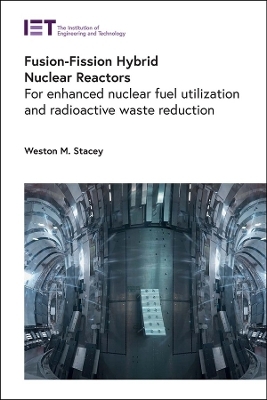
Fusion-Fission Hybrid Nuclear Reactors
Institution of Engineering and Technology (Verlag)
978-1-83953-651-9 (ISBN)
Nuclear energy is contributing to the long-term solution to stave off climate change. However, current nuclear fission technology accesses only about 1-3% of the nuclear energy content of natural uranium, which is inefficient, and also creates a radioactive waste disposal problem.
Combining nuclear fission technology with emerging nuclear fusion technology to create a fusion-fission hybrid would yield extra fusion neutrons to 1) convert much more of the uranium into fissionable material, which would increase efficient utilization of the nuclear fuel resource, and 2) significantly reduce (by fission) the most long-lived radioactive nuclear waste.
This book describes fusion-fission hybrid physics and technology. The first parts briefly review nuclear fission principles and describe design and safety of nuclear fission reactors; then the fundamentals of nuclear fusion and fusion reactor concepts are described, together with ongoing and future challenges and anticipated developments in this not-yet matured technology. Chapters cover the scientific basis of nuclear fission and the fission fuel cycle, advanced fission reactors, safety aspects, the scientific and technological basis of nuclear fusion power, future improvements expected, and then the fusion-fission hybrid (FFH) breeder and burner reactor concept principles, with illustrative FFH design concepts, safety analyses, and examples of the use of fusion neutrons for helping to achieve burning and breeding fission fuel cycles.
This concise work is essential reading for researchers and policy makers in nuclear energy research and engineering, including advanced students.
Weston M. (Bill) Stacey is emeritus Regent's Professor of Nuclear Engineering at Georgia Institute of Technology, United States. His career in nuclear science and engineering spans 60+ years of research in nuclear reactor physics and nuclear reactor design, fusion plasma physics and fusion reactor design, at Knolls Atomic Power Laboratory, Argonne National Laboratory and Georgia Tech. He led the international IAEA INTOR Workshop (USA, USSR, EU, Japan, 1977-88) project to assess the readiness of the world's fusion programs to build an experimental fusion power reactor, to evaluate the required additional R&D, and to develop the INTOR conceptual design; this project evolved into the current ITER project for the first experimental fusion reactor. He is author of more than 350 research papers and 7 books on nuclear fission and fusion physics and technology and recipient of the ANS Seaborg and Wigner Reactor Physics awards, the DOE Distinguished Associate award and two Certificates of Appreciation, the Fusion Power Assoc. Distinguished Career award, and is a lifetime member of Who's Who.
Chapter 1: Introduction
Chapter 2: Nuclear electric power production
Chapter 3: Scientific basis of nuclear fission energy
Chapter 4: Uranium nuclear fission power fuel cycle
Chapter 5: Fission energy fuel resources
Chapter 6: Technological basis of nuclear fission power
Chapter 7: Conversion of nuclear fission energy to electrical energy
Chapter 8: Advanced fission reactors
Chapter 9: The Nuclear Reactor Physics, Nuclear Reactor Engineering, Plasma Physics, and Fusion Technology disciplines
Chapter 10: Safety of nuclear fission power reactors
Chapter 11: The nuclear fission power fuel cycle
Chapter 12: Scientific and technological basis of nuclear fusion power
Chapter 13: Nuclear fusion power reactor studies
Chapter 14: Future improvements in fusion physics and technology
Chapter 15: Fusion-fission hybrid reactors
Chapter 16: Principles and technical rationale of the fusion-fission hybrid breeder and burner reactors
Chapter 17: Illustrative future fusion-fission hybrid reactor designs
Chapter 18: SABR tokamak burner fuel cycles (using fusion neutrons to fission nuclear waste and close the back end of the fission fuel cycle
Chapter 19: Computational models for tritium breeding ratio and fissile breeding ratios
Chapter 20: Physics and engineering design constraints on fusion-fission hybrids
Chapter 21: Status of fusion development vis-à-vis a neutron source for FFH
Chapter 22: Fusion neutron enhancement of a breeding nuclear fission fuel cycle
Chapter 23: Using fusion neutrons to achieve a burning fission fuel cycle
Chapter 24: Fuel cycle methodology, summary and conclusions
Chapter 25: Using fusion neutrons to achieve a breeding fission fuel cycle
Chapter 26: Dynamic safety analyses of FFH reactors
Chapter 27: Space-dependent dynamics calculation model for a sodium pool-cooled fast transmutation reactor (SABR#2)
Chapter 28: The panacea of just harvesting "free" green energy?
Chapter 29: Summary, discussion, and recommendations
| Erscheinungsdatum | 17.08.2022 |
|---|---|
| Reihe/Serie | Energy Engineering |
| Verlagsort | Stevenage |
| Sprache | englisch |
| Maße | 156 x 234 mm |
| Themenwelt | Technik ► Elektrotechnik / Energietechnik |
| ISBN-10 | 1-83953-651-9 / 1839536519 |
| ISBN-13 | 978-1-83953-651-9 / 9781839536519 |
| Zustand | Neuware |
| Haben Sie eine Frage zum Produkt? |
aus dem Bereich


